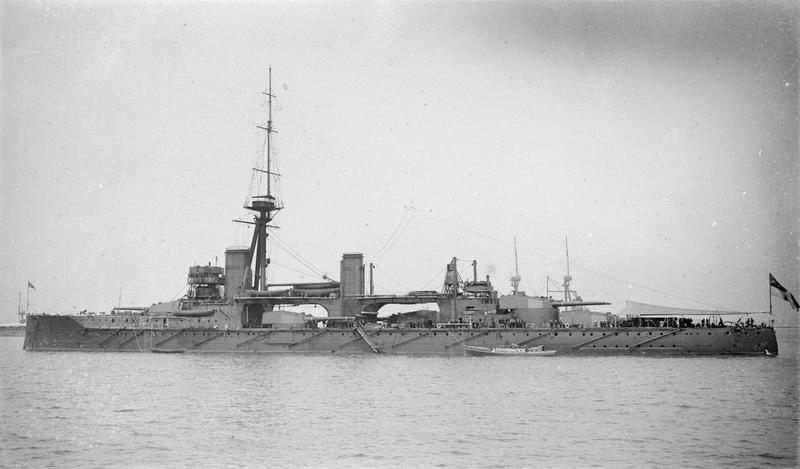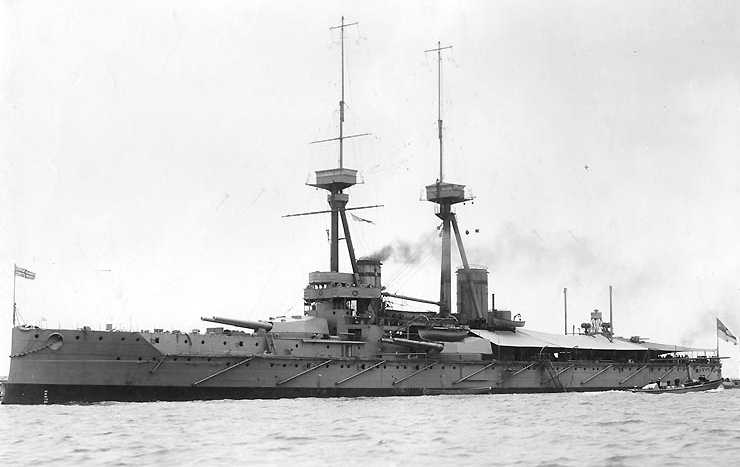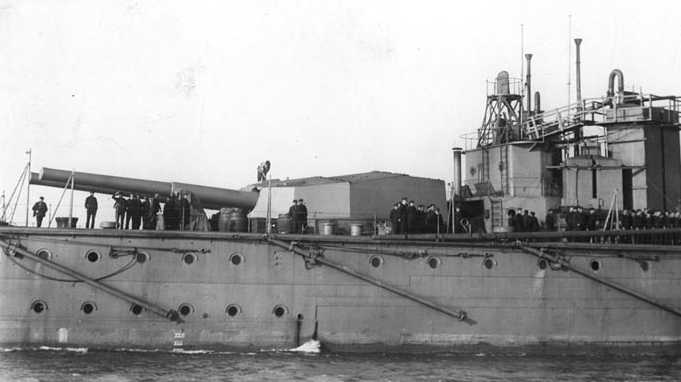
Developed to arm the "next generation" of dreadnoughts, this was a long-barrel 12" (30.5 cm) gun that used a larger propellant charge in order to achieve a higher muzzle velocity. Unfortunately, these new weapons proved inaccurate, as the heavier charge did not always fully combust before the shell left the muzzle. This resulted in unpredictable muzzle velocities and thus a varying range for the same elevation. Following one set of exercises, Lord Fisher recorded that the salvo shell patterns were spread over two or three acres (1 to 1.5 hectacres). The higher muzzle velocities achieved also resulted in these guns having a relatively short service life. There are some comments in the references below about muzzle droop in the Mark XI, but Campbell says that gun measurements showed between 4.2 and 4.8 minutes (average 4.5) compared to the calculated 4.55 minutes. A test showed that firing five rounds at 25 minute intervals reduced droop by 3 minutes.
Some publications claim that these weapons were used on the Indefatigable class battlecruisers, but all British 12" (30.5 cm) battlecruisers actually used the older - and shorter - 12"/45 (30.5 cm) Mark X guns.
The Marks XI, XI* and XII were interchangeable and had similar ballistic performance. The Mark XI was a Vickers design and resembled the Mark X except that the screwed collar was replaced by a breech ring screwed to the rear jacket. One of these guns used on HMS Vanguard had a Holmstrom breech mechanism while the others used the same "pure-couple" breech mechanism as the Mark X. The original prototype was a Vickers design and not wired all the way to the muzzle. This had a long cylindrical chamber which was intended to reduce erosion and to make ballistic performance more repeatable. However, by 1909 neither of these had been demonstrated and the longer chamber reduced rifled length and thus muzzle velocity. The prototype suffered a cracked A tube after firing the equivalent of 38 full service rounds. Investigation showed that the design drawings had too little allowance for shrinkage of the gun parts during construction which gave too little margin for safety. It was also stated that even with the correct shrinkage the guns would not be absolutely reliable. As a corrective measure, the jacket and B tube were cut off in front of the wired section, new wiring was applied out to the muzzle and a new B tube was added with a collar to secure it to the jacket. This added about a ton (1.1 mt) to the overall gun weight. The new B tube was kept thin so that the external shape of the gun was about the same except for the new collar. In 1909 the Ordnance Board required that new guns be wired to the muzzle. These were designated as the Mark XI* and had a short B hoop overlapped by the jacket and the C hoop shrunk over the B tube and screwed onto the jacket. To counterbalance this, a D hoop was added over the jacket in front of the breech ring. This allowed the guns to be used in the existing mountings without changes. As a result of these modifications, the XI* also weighed a ton more than the original Mark XI. The Mark XII was an improved design by the Royal Gun Factory and had about the same weight as the Mark XI but differed from it by having more wire along the chase.
Single guns with minor differences were also made to Elswick, Beardmore and Coventry Ordnance designs, apparently to ensure that these manufacturers could produce acceptable large-caliber guns. Mark XI**, XI*** and XII* were proposed variations that were to have had alterations to the chamber slope for use at high elevations, but none of these were ordered. A total of 85 guns of all types were made.
Some experimental work for these guns was carried out with pre-rifled 12" (30.5 cm) projectiles fired at muzzle velocities exceeding 3,000 fps (914 mps) and work was begun on converting one gun to a super velocity 8.071 inch (20.5 mm) gun, known as the 8-inch (20.3 cm) subcaliber Mark II. This was a continuation of the experimental work started with the 8-inch subcaliber Mark I. The work was cancelled at the end of the war.
| Designation | 12"/50 (30.5 cm) Marks XI, XI* and XII |
|---|---|
| Ship Class Used On | St. Vincent, Neptune and Colossus Classes |
| Date Of Design | Mark XI: 1906
Mark XII: 1909 |
| Date In Service | 1910 |
| Gun Weight | Mark XI without Breech: 147,056 lbs. (66,703 kg)
Mark XI and XII with Breech: 149,408 lbs. (67,770 kg) Mark XI* with Breech: 151,648 lbs. (68,786 kg) |
| Gun Length oa | 617.7 in (15.690 m) |
| Bore Length | 600 in (15.240 m) |
| Rifling Length | 481.5 in (12.230 m) |
| Grooves | (48) 0.1 in deep x 0.448 in wide (2.5 mm D x 11.4 mm W) |
| Lands | 0.18 in (4.6 mm) |
| Twist | Uniform RH 1 in 30 |
| Chamber Volume | 23,031 in3 (377 dm3) |
| Rate Of Fire 1 | about 1.5 rounds per minute |
- ^The Rate of Fire figure given above is found in references for British guns of this caliber, but "Warrior to Dreadnought: Warship Development 1860-1905" quotes Jellicoe's 1906 figures for rates of fire for these guns in gunlayers' tests and in battle practice and notes that the latter figures corresponded well to those actually attained by the Japanese at Tsushima:
Gunlayers Test: 2 rounds per minute
Battle Practice: 1 round per minute - Danger space for this gun against a 30 foot (9 m) target was estimated as follows:
120 yards at 8,000 yards (110 m at 7,300 m)
63 yards at 12,000 yards ( 58 m at 10,970 m)
36 yards at 16,000 yards ( 33 m at 14,630 m)
| Type | Bag |
|---|---|
| Projectile Types and Weights 1a | APC Mark VIa (4crh): 859.4 lbs. (389.8 kg) 2a APC Mark VIIa (Greenboy) 3a : 854 lbs. (387.4 kg) CPC Mark VIIa: 850 lbs. (386 kg) HE Mark IIa: 850 lbs. (386 kg) |
| Bursting Charge | APC Mark VIa: 27.3 lbs. (12.4 kg)
APC Mark VIIa: 20.3 lbs. (9.2 kg) CPC Mark VIIa: 80 lbs. (36.3 kg) HE Mark IIa: 106.5 lbs. (48.3 kg) |
| Projectile Length | APC Mark VIa: N/A
APC Mark VIIa: 38.0 in (96.5 cm) CPC Mark VIIa: 48.4 in (122.9 cm) HE Mark IIa: 48.3 in (122.7 cm) |
| Propellant Charge | 307 lbs. (139.3 kg) MD45 4a 5a |
| Muzzle Velocity | 2,852 fps (869 mps) |
| Working Pressure | 18.5 tons/in2 (2,910 kg/cm2) |
| Approximate Barrel Life | Mark XI: 75 - 80 rounds
Mark XI*: N/A (probably about 200 rounds) Mark XII: 220 rounds |
| Ammunition stowage per gun | St. Vincent: 80 to 100 rounds
Neptune: 100 rounds Colossus: 100 rounds |
- ^Projectile weights from ADM 186/169. The sources below disagree as to muzzle velocity, propellant charge weights and maximum ranges. I have chosen to use those values given in "Jutland: An Analysis of the Fighting."
- ^It would appear that these ships did not carry the older 2crh 12" (30.5 cm) APC Mark VI.
- ^"Greenboys" were issued starting in 1918.
- ^The original charge weight was 337 lbs. (152.9 kg) MD55 but was reduced to the figure and MD type above in an effort to improve accuracy.
- ^HMS Vanguard was destroyed on 9 July 1917 by a magazine explosion caused by deteriorating MD cordite or possibly a smoldering coal fire, killing all but two men out of the 845 on board at the time. This tragedy spurred the replacement of all existing cordite in the Royal Navy with the newer, more stable MC cordite. See Naval Propellants in the History and Technology section for more information on the various kinds of British Cordite and other naval propellants. For further information on the destruction of HMS Vanguard, see Scapa Flow Wrecks.
- For other information regarding ammunition for these guns, please see the 12"/45 (30.5 cm) Mark X datapage.
| Elevation | Range | Striking Velocity | Angle of Fall |
|---|---|---|---|
| 2.0 degrees | 5,000 yards (4,570 m) | 2,276 fps (694 mps) | 2.3 |
| 3.5 degrees | 7,500 yards (6,860 m) | 2,037 fps (621 mps) | 4.1 |
| 4.7 degrees | 10,000 yards (9,140 m) | 1,821 fps (555 mps) | 6.3 |
| 6.1 degrees | 12,500 yards (11,430 m) | 1,632 fps (497 mps) | 9.3 |
| 8.4 degrees | 15,000 yards (13,720 m) | 1,495 fps (456 mps) | 13.0 |
| 10.7 degrees | 17,500 yards (16,000 m) | 1,374 fps (419 mps) | 17.3 |
| 13.2 degrees | 20,000 yards (18,290 m) | 1,302 fps (397 mps) | 22.2 |
| 15.0 degrees | 21,200 yards (19,380 m) | --- | --- |
| Range | KC Side Armor | Striking Velocity |
|---|---|---|
| 0 yards (0 m) | 16.8" (427 mm) | 3,010 fps (917 mps) |
| 10,000 yards (9,144 m) | 11.2" (284 mm) | 2,000 fps (610 mps) |
Data from "British Battleships of World War Two" and represents an uncapped AP shell striking a plate at 90 degrees, i.e., with the axis of the shell perpendicular to the face of the plate. A capped shell would give about 10 to 20% improvement at low velocities and about 30 to 50% at high velocities. Note that the muzzle velocity was considerably higher than even that of new guns during the World War I period.
In 1912 DNO produced a table of penetration of KC armor by the Mark XI guns. Penetration was in terms of calibers penetrated by 4crh shells.
| Range | AP 4crh | CCP 4crh |
|---|---|---|
| Between 10,000 and 12,000 yards (9,140 and 10,970 m) | 3/4 | 5/6 1b |
| Between 8,000 and 10,000 yards (7,320 and 9,140 m) | 4/5 | 3/4 |
| 8,000 and below yards (7,320 and below m) | 1 | 5/6 |
- ^This may be a mistype as the same value is used for the 8,000 yards and below entry. Possibly this should be 2/3.
- Data from "Naval Weapons of World War One" by Friedman.
See Pre-War Armor Penetration for comments regarding the actual penetration capabilities of British pre-war 12 inch (30.5 cm) AP projectiles.
| Designation | Two-gun turrets
St. Vincent (5), Neptune (5) and Colossus (5): BXI |
|---|---|
| Weight | 510 - 540 tons (518 - 549 mt) |
| Elevation | -3 / +15 degrees |
| Rate of Elevation | N/A |
| Train | Forward and Aft Turrets: about -150 / +150 degrees
Beam Turrets: about +30 / +150 degrees Q Turret: about +30 / +150 degrees on either side |
| Rate of Train | 4 degrees per second |
| Gun Recoil | N/A |
| Loading Angle | +5 degrees |
- HMS St. Vincent had six-cylinder training engines but later ships were unique among British 12 in (30.5 cm) mountings in that they used a swash-plate training engine.
- Each ship had three hydraulic pumps for powering the mountings, but these proved inadequate in service. HMS Neptune found that she could not run out four guns simultaneously while using training engines and hoists.
- Gun axes were 90 inches (228.6 cm) apart.
- HMS Neptune had significant "firsts" for British battleships. She was the first equipped with a superimposed turret, the first to be able to fire a broadside with all main guns and the first to be fitted with a director sight. None of these "firsts" were entirely successful. As the turret sighting ports were open, the superimposed turret could not fire directly over the the lower one as this would have allowed blast and overpressures to penetrate into the lower turret. Stops were fitted to prevent this from occurring. During initial gunnery trials it was found that when the amidships turrets fired cross-deck that the deck sagged appreciably from the blast effect. Extra pillars and "Z" bars were fitted to strengthen these areas. Astern and ahead fire was also restricted for all turrets to angles greater than 5 degrees to prevent blast damage to the deck and superstructure. The original director did not live up to expectations and a modified version was installed in 1912 on HMS Thunderer which proved to be more successful.
- Similar to what had been found during gunnery trials with Neptune, when HMS Colossus fired cross-deck during the Jutland (Skagerrak) battle "the framing and deck supports were badly strained, especially after full-charges had been used" - R.A. Burt in "British Battleships of World War One."
- In 1906-07 the Royal Navy investigated triple turrets but abandoned the idea. Armstrong developed a design and only the final signature was lacking on the order to proceed when it was suddenly cancelled. Armstrong was told that the triple turret was considered to be too complicated and that the planned increase to 13.5 inch (34.2 cm) guns made it unnecessary. Related projects to link up individually sleeved guns in a turret or to use a common slide as in some USN turrets were similarly cancelled.
- Turret Armor as given in "Naval Weapons of World War One":
Face, sides and rear: 11 in (28 cm)
Roof (all except St. Vincent): 3 to 4 in (7.6 to 10.2 cm)
Roof (St. Vincent): 4 in (10.2 cm)


"Warrior to Dreadnought: Warship Development 1860-1905" and "The Grand Fleet: Warship Design and Development 1906-1922" both by D.K. Brown
"British Battleships of World War One" by R.A. Burt
"Jutland: An Analysis of the Fighting" and "British Naval Guns 1880-1945 No 4" article in "Warship Volume V" both by John Campbell
"Battleship Design and Development 1905-1945" and "Naval Weapons of World War I" both by Norman Friedman
"The Big Gun: Battleship Main Armament 1860-1945" by Peter Hodges
"Policy and Operations in the Mediterranean 1912-14" by E.W.R. Lumby
"British Battleships of World War Two" by Alan Raven and John Roberts
"A Concentrated Effort: Royal Navy Gunnery Exercises at the End of the Great War" article by William Schleihauf in "Warship International" No. 2, 1998
---
ADM 186/169 "Shell Committee: Reports 1917 and 1918"
---
Special help from Dave Alton and Neil Stirling
25 August 2008 - Benchmark
30 January 2009 - Added additional construction details and comments on experimental work
12 March 2012 - Additional comments on sub-caliber experimental work
01 February 2014 - Added photograph of HMS Colossus and note regarding Neptune firsts
23 September 2016 - Converted to HTML 5 format
21 December 2017 - Minor addition
29 February 2020 - Reorganized notes
24 January 2021 - Added information on development of the Mark XI and Mark XI*, DNO armor penetration table,
mounting notes regarding gun axes and pumps, and Turret Armor thickness
22 January 2022 - Added note about loss of HMS Vanguard and link to Scapa Flow Wrecks website
